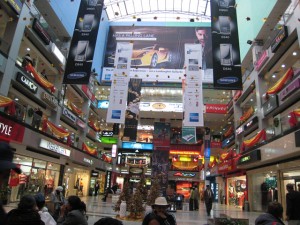 Track2Realty: The overall mall vacancy levels across the top eight India cities remained stagnant at 14.47% in Q2 2014, which was recorded around 0.4 percentage points lower compared to Q1 2014. Amongst the top eight cities, Pune witnessed sharpest decline of 2.5 percentage points due to healthy leasing activity and no new mall supply. These are the findings of Cushman & Wakefield latest report.
Track2Realty: The overall mall vacancy levels across the top eight India cities remained stagnant at 14.47% in Q2 2014, which was recorded around 0.4 percentage points lower compared to Q1 2014. Amongst the top eight cities, Pune witnessed sharpest decline of 2.5 percentage points due to healthy leasing activity and no new mall supply. These are the findings of Cushman & Wakefield latest report.
Ahmedabad, Chennai and Bengaluru also recorded drops of 0.4 percentage point each due to moderate demand for quality mall spaces from apparels and food and beverages (F&B) retailers. Hyderabad witnessed a rise of 1.1%, in mall vacancy in the same period.
Q2 2014 saw the addition of 370,000 sf. of new mall space, which was similar to that received in the previous quarter. The supply comprised of 250,000 sf in one mall in NCR and the residual 120,000 sf in an operational mall in Kolkata.
As many as 6 new malls planned for Q2 2014 witnessed the deferment to the second half of the year, which together accounted for 2.33 million square feet (msf). While 3 malls measuring 700,000 sf in total were delayed in Bengaluru due to approval delays, slower construction pace in tandem with low leasing led to deferment of one mall each in NCR, Pune and Hyderabad, measuring 700,000 sf, 430,000 sf and 500,000 sf respectively.
| City | Mall Vacancy Q2 2013 | Mall Vacancy Q1 2014 | Mall Vacancy Q2 2014 | Supply
Q2 2014 |
| (in million sq. ft.) | ||||
| Ahmedabad | 31.50% | 31.58% | 31.16% | 0.00 |
| Bengaluru | 11.95% | 7.50% | 7.10% | 0.00 |
| Chennai | 6.11% | 6.24% | 5.88% | 0.00 |
| Hyderabad | 1.40% | 7.11% | 8.22% | 0.00 |
| Kolkata | 4.54% | 3.57% | 3.64% | 0.12 |
| Mumbai | 15.05% | 15.29% | 15.35% | 0.00 |
| NCR | 14.42% | 13.44% | 13.50% | 0.25 |
| Pune | 26.71% | 27.48% | 25.03% | 0.00 |
| TOTAL | 15.04% | 14.51% | 14.47% | 0.37 |
Sanjay Dutt, Executive Managing Director, South Asia Cushman & Wakefield, said, “The retail and retail real estate markets are still going through a period of uncertainty. Currently, we are witnessing stagnation in the demand-supply dynamics as mall supply is being deferred and existing vacancies remain more or less stable. Whilst everyone is aware of the huge potential that exists for organized retail in India and domestic and international retailers are keen to expand their presence in the country, they are awaiting the conducive conditions to do so. The real estate sector has been maturing to provide better quality spaces and adopting best practices to cater to retailers needs. However, macroeconomic conditions and not just the sentiments need to improve further to encourage consumer spending and the Government needs to address the uncertainty that exists with respect to its policy stand on FDI in retail. The RIET’s for commercial properties post successful listings, would potentially open up for shopping center portfolio listings, giving much needed exit route to the developers & investors. This would encourage shopping centre developers to create much needed quality organized retail space at locations that matter. The overall infrastructure to support retail trade such as transportation and logistics too need to improve substantially for the sector to kick in to its next phase of growth.”
According to C&W, mall rentals remained stable across most cities except Bengaluru, Chennai, Mumbai and Pune where a few micro markets depicted rental variations. In Bengaluru, the sharpest rental decline of 13% was noticed in Mysore Road where lower trade densities impacted rentals adversely. Similarly, Cunningham Road in Bengaluru also witnessed lower demand leading to a 10% dip in rentals.
On the other hand, Goregaon in Mumbai witnessed a 10% increase in mall rentals due to healthy demand from retailers. In Pune, Hadapsar also witnessed a positive trend in leasing leading to a 9% uptick in mall rentals. In Chennai, almost all mall micro markets witnessed a rental decline from the last quarter due to weakening demand. The sharpest rental dip of 9% came in Chennai-Western where lack of new mall supply hampered retailer demand for this location. Mall rentals in Hyderabad, Ahmedabad and Kolkata remained stable.
In Pune, JM Road witnessed the highest rental appreciation of 9% due to high demand from fashion and lifestyle retailers. Vashi in Mumbai also witnessed similar rental appreciation due to high interest from apparels and F&B retailers. In Chennai, lack of optimum sized retail spaces led to a 7% decline in main street rentals. Anna Nagar 2nd Avenue in Chennai also witnessed a 7% dip in rentals from last quarter as ongoing infrastructure projects curtailed footfalls.
All main streets in NCR, Ahmedabad, Hyderabad and Kolkata recorded stable rentals during this quarter. Vittal Mallaya Road in Bengaluru witnessed a 4% rental drop in wake of dearth of optimum-sized retail spaces and already high rentals commanded by this established main street.
During H1 2014, Bengaluru witnessed no new mall supply; this was primarily owing to the delay in approvals, which led to the deferment of upcoming supply. Meanwhile, the city mall vacancy level registered a dip of 0.4 percentage point and was noted at 7.1% towards the end of Q2 2014 due to the absence of new mall supply and moderate demand from apparels, F&B, footwear and electronics retailers. Although most locations in main streets and mall micro markets recorded stable rental trend this quarter, select main streets and mall micro-markets registered a drop in rentals.
Whilst Cunningham Road and Mysore Road mall micro markets witnessed a decline of 10-13% in rentals in the wake of weak trading activity; Bannerghatta Road mall micro market recorded a drop of 3% in order to keep rentals competitive and attract newer brands. Main streets of Brigade Road and Vittal Mallya Road observed a drop of 3-4% in rentals due to limited availability of options with optimum sized floor plates.
Going forward, Cunningham Road and Mysore Road mall micro markets may experience further downward pressure on rentals. On the other hand, established main streets such as Indiranagar 100 Feet Road, New BEL Road, Kamanahalli Road and Koramangala 80 Feet Road may witness an upward rental bias owing to healthy enquiries from apparels, F&B, electronics and jewelry brands.
In H1 2014, Chennai did not witness any new shopping malls becoming operational and this led to a marginal decline of 0.4 percentage points in vacancy, which was recorded at 5.9% at the end of this quarter. Cautious sentiments and limited transactions led to a dip in mall rentals across all micro markets.
Chennai-Western saw the sharpest decline with a 9% drop owing to the ongoing infrastructure projects, which curtailed footfalls and demand. Amongst main streets, strong demand from jewelry retailers for Usman Road- North and Usman Road- South led to a 4% rental appreciation for these locations.
However, no availability of optimum sized floor plates in Cathedral Road-R.K. Salai led to a 7% rental dip for this micro market. Enquiries from jewelry retailers for select main streets near CBD remain high but Anna Nagar-2nd Avenue may witness a negative rental bias due to lack of demand caused by the ongoing metro work. Paucity of quality mall space and low demand may lead to stagnant vacancy levels and rental decline across most micro markets.
The mall stock in Hyderabad remained stable in Q2 2014, with 500,000 sf mall space deferred to the next quarter. Q2 2014 witnessed a rise in vacancy by 1.1 percentage points and was noted at 8.22%. Established main streets such as Himayathnagar, Banjara Hills, Jubilee Hills and Kukatpally witnessed an increase in demand from retailers, belonging to apparels, footwear and F&B categories.
In the interim, enquiry level for electronic and apparels brands increased in peripheral locations such as Attapur and Kothapet. Whilst mall and main street rentals remained stable, next quarter the city is likely to witness infusion of 500,000 sf of mall space in Kukatpally micro market, which will put a downward pressure on the rentals.
Kolkata witnessed 120,000 sf of mall supply during the first half of 2014 and the overall city mall vacancy increased marginally by 0.07 percentage points. Limited transactions and moderate demand for retail space was recorded. Owing to lack of availability of quality retail space on main streets, malls witnessed more demand compared to main streets.
Central and East locations continued to see majority of the leasing activity in both malls and main streets owing to churn and ready catchment. The first half of 2014 witnessed leasing activity predominantly from the apparels segment but rentals remained stable in both main streets and malls.
The first half of 2014 did not witness the opening of any new malls in Mumbai. Despite no new supply, churn in malls led to overall mall vacancies increasing marginally by 0.06 percentage points to 15.4%. During Q2, healthy demand led to mall rentals at Goregaon and Vashi appreciating 10% and 5% respectively while high vacancy levels in malls in Bhandup resulted in developers reducing rentals by 5% to attract retailers.
Limited churn kept mall rentals stable in all other locations of the city. Main streets in Mumbai witnessed vibrant leasing activity with domestic and foreign retailers in the apparels and F&B segments actively expanding their presence at locations like Vashi, Lower Parel, Andheri and Linking Road. Owing to high footfall and thriving retail demand in Vashi, strong interest of retailers led to rentals appreciating by 9%.
Mall rentals at select locations such as Lower Parel and Malad could appreciate due to higher demand for quality space. Main streets are also expected to witness improved leasing activity in the coming months. Increasing demand for space in main street locations such as Linking Road, Borivali and Thane could lead to increase in rental values.
Delhi-NCR witnessed one new shopping mall measuring 250,000 sf become operational with 60% occupancy levels in H1 2014. Amidst moderate interest among retailers to foray into new and emerging locations, developers continued with slow pace of construction deferring completion of malls.
During Q2 2014, overall mall vacancy was recorded at 13.5%, which is 0.06 percentage points higher due to the influx of new mall space. With balanced demand supply conditions, rentals remained stable across all mall locations. H1 2014 witnessed continued interest from retailers in prominent main street locations such as Greater Kailash (I & II), Connaught Place, Lajpat Nagar, Karol Bagh, Khan Market and Defence Colony.
The highest demand was witnessed from F&B brands followed by jewelry, apparels, electronics and lifestyle brands. Despite healthy demand, rentals across main street locations maintained status quo as both retailers and landlords exhibited sensitivity towards any rental change given the competitive retail landscape in Delhi-NCR.
Most of the transaction activity in malls of Pune took place in the micro markets of Hadapsar and Pimpri while few malls in Koregaon Park and Camp also witnessed an improvement in leasing activity. Though rental values in most mall micro markets remained stable, Hadapsar witnessed an increase of nearly 9% due to high retailers’ interest.
Though Pune witnessed 350,000 sf of mall supply in the first quarter of 2014, pick-up in leasing activity coupled with no mall supply in the second quarter led to a drop of 2.45 percentage points in vacancy levels, which is now at 25.0%. Transaction activity in the coming months is expected to remain stable in malls. JM Road remained one of the most preferred main street locations, registering an 8.6% increase in rental values.
Fashion and lifestyle brands contributed to majority of the transaction activity in main street locations. Outlook for JM Road, FC Road and Aundh continues to remain positive due to healthy demand for these markets.
Limited availability of quality mall space kept transaction activity low in Ahmedabad. A few transactions by local brands at S.G. Highway led to mall vacancies declining by 0.4 percentage points to 31.2%. Given high mall vacancy levels and a high preference for main streets, Ahmedabad did not witness any mall supply and has no mall under construction.
Despite high vacancy existing in some malls, landlords kept the mall rentals stable. Limited retail expansions were noted, which was concentrated in select main streets such as C.G. Road. Due to the attractive catchment and high footfalls, a few domestic brands opened their first stores on C.G. Road.
Low transaction activity kept rentals stable across all main streets. Increasing enquiries, especially from apparels and lifestyle brands for locations such as C.G. Road and Prahladnagar could result in rentals increasing in the next quarter. Mall rentals in S.G. Highway could witness a correction due to existing high vacancy levels.





